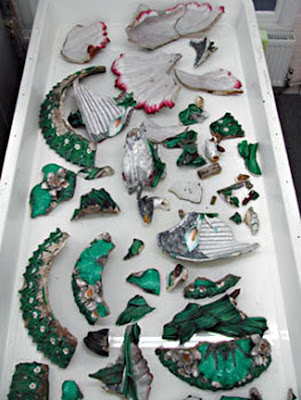Dozens of companies potted majolica during the second half of the Nineteenth Century. For most it was a sideline to their regular business. As fashions changed they dropped out of production without really making a mark with their majolica wares and as such are rarely discussed in any survey of majolica. Dudson pottery was one of these small potters.
In 1800 Richard Dudson founded the Dudson pottery on Broad Street in Hanley. So began a 200+ year old successful business run by several generations of the Dudson family. Dudson specialized in earthenware, salt glaze, parian and especially Wedgwood type jasperware. They also made majolica.
The craftsmanship at the pottery was always first rate. Their jasper work was dependable and often quite beautiful with a distinctive style. Unfortunately their concentration on jasper, a form that was invented by Wedgwood, unfairly branded them a reputation as "the poor man's Wedgwood."
The company also made full color examples of their most popular salt glaze and parian designs such as the tulip pitcher shown below.
Other majolica designs sold by the company remained faithful to their jasper ware kin.
Spittoons in both Rose and Begonia designs are also described in the literature.
Majolica production in the popular bronze green glaze continued at Dudson through the first third of the Twentieth Century. After the start of WW2 the company completely ceased majolica production.
In 1800 Richard Dudson founded the Dudson pottery on Broad Street in Hanley. So began a 200+ year old successful business run by several generations of the Dudson family. Dudson specialized in earthenware, salt glaze, parian and especially Wedgwood type jasperware. They also made majolica.
 |
| Interior of the Dudson Pottery workroom |
The craftsmanship at the pottery was always first rate. Their jasper work was dependable and often quite beautiful with a distinctive style. Unfortunately their concentration on jasper, a form that was invented by Wedgwood, unfairly branded them a reputation as "the poor man's Wedgwood."
In 1881 the company announced the beginning of majolica production. According to Audrey Dudson, whose books are considered the definitive works on the company, the most popular majolica made by the company was mottled green majolica such as the twisted rope example shown below. While majolica was not a major line for Dudson this particular line of brown and green mottled ware—known as "bronze green" within the company—was a consistant seller for them.
 |
| Image from Audrey Dudson's seminal book on the Dudson Pottery |
 |
| Trade ad for Dudson Pottery |
The company also made full color examples of their most popular salt glaze and parian designs such as the tulip pitcher shown below.
Other majolica designs sold by the company remained faithful to their jasper ware kin.
Spittoons in both Rose and Begonia designs are also described in the literature.
Over the years we have seen many pieces identified as Dudson majolica but without marks or other corroborative evidence we are reluctant to list them here.
The company remains active today in the production of utilitarian wares for the hospitality industry.









































